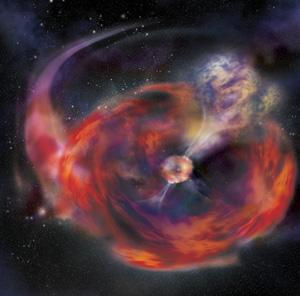
Object type: Gamma-ray burst
Constellation: Andromeda
The timing could hardly have been more auspicious. Like a 2000-year-old gamma-ray echo of the biblical star of Bethlehem, on Christmas day 2010 an unprecedented tussle broke out in the heavens.
It sent a flood of high-energy radiation towards Earth that lasted much longer than is typical for a gamma-ray burst (GRB). Now it seems the peculiar event clashes with the leading theory for how such blasts of radiation form, and may instead involve the grisly demise of a comet.
At 18:37 GMT on 25 December 2010, the spectacular light show erupted, though you would have needed gamma-ray eyes to see it. Researchers did the next best thing, watching it with instruments on NASA's Swift satellite.
Gamma-rays are extremely energetic photons and it takes a very violent event to produce them in large quantities. Hundreds of GRBs flash on and off in the sky like fireflies each year. Satellites designed to detect nuclear bomb blasts first noticed them in the late 1960s and the Swift satellite was launched in 2004 to study them in greater detail.
X-ray spikes
Swift's observations have bolstered the two main theories for how GRBs form. Short bursts lasting less than a couple of seconds appear to arise when two neutron stars, ultra-dense remnants of dead stars, collide. Longer bursts lasting up to a few minutes may be due to the collapse of massive stars to form a black hole or neutron star.
But the Christmas burst kept pumping out gamma-rays for half an hour - much longer than normal. Like other GRBS, it also gave off an X-ray glow that lasted longer than the gamma rays. But X-rays from a normal GRB tend to fade smoothly. Those from this GRB spiked every hour or two for the first 10 hours.
The event's unusual characteristics have led researchers to dust off one of the earliest theories for the origin of gamma-ray bursts: that they come from comets that stray too close to neutron stars.
Massive teaspoon
Neutron stars are ultra-dense balls of neutrons, subatomic particles left behind when a massive star burns out and collapses. A teaspoon of neutron-star material contains a mass in the billions of tonnes. As a result, a typical neutron star weighs slightly more than the sun, despite being only about 20 kilometres across.
The high density gives neutron stars very powerful gravitational fields, rivalling that of a black hole. A comet straying within a few thousand kilometres of a neutron star would be torn to shreds.
The comet fragments would then rain down on the neutron star, unleashing a torrent of gamma rays when they reach its surface. Crucially, these clumps of matter falling onto the star could also produce the signature X-ray spikes that were a feature of the Christmas GRB, says a team led by Sergio Campana of the Brera Astronomical Observatory in Merate, Italy, in Nature.
Christmas death
But comet slaughter isn't the only explanation, according to a second team led by Christina Thöne of the Institute of Astrophysics of Andalusia in Granada, Spain. In another study in Nature, they argue that a neutron star merging with a red giant star could also explain the unusually long-lived Christmas burst. Such a smash-up with a red giant would unleash much more energy than the decimation of a comet, so would have to occur in a distant galaxy to avoid appearing brighter than what was observed.
The event remains mysterious for now, since definitive proof is lacking for either scenario, writes Enrico Costa of the Space Astrophysics and Cosmic Physics Institute in Rome, Italy, in a commentary in Nature. But the Christmas event is a clear reminder that we have so much to learn about the causes of violent GRBs.
"Whatever the case, it's hard to escape the fascination of a possible comet death on Christmas Day," Costa writes.
Reference: Nature, DOIs: 10.1038/nature10592 and 10.1038/nature10611



Thornhill and Talbot's Electric Universe Theory disputes the mainstream "science" about neutron stars.
You can search their homepage for "neutron star" at this URL:
[Link]
This is one of the articles that I encountered:
[Link]